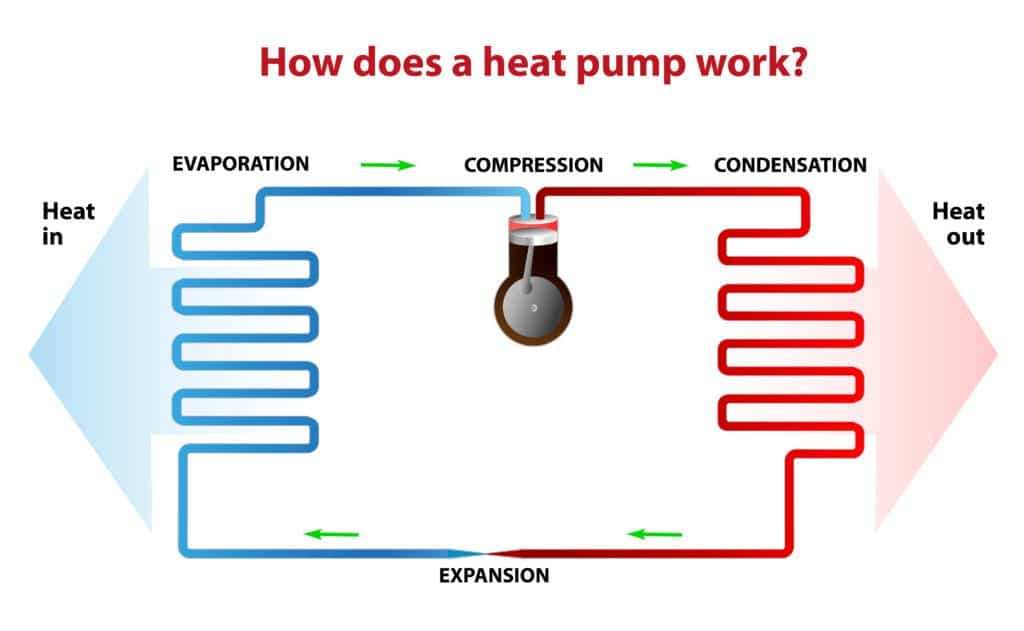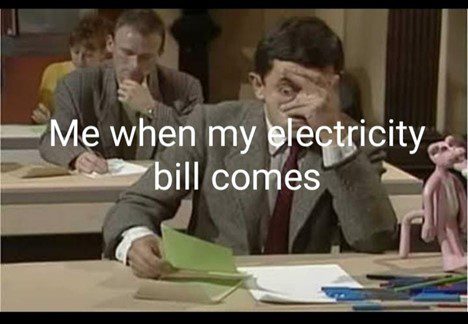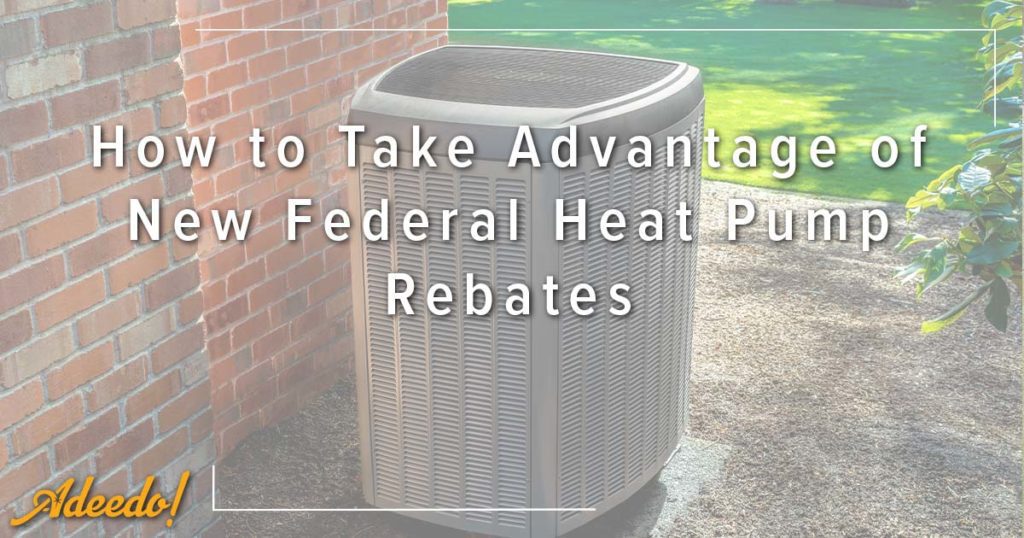If you’re looking to make energy-efficient home upgrades in 2023, you’re in luck! The Inflation Reduction Act of 2022 (IRA) was signed into law by the Biden Administration on August 16, 2022, to incentivize homeowners to transition to cleaner energy.
The Inflation Reduction Act
The IRA was intended to reduce carbon emissions, fund the Internal Revenue Service, offset the effects of inflation, reduce healthcare costs, and improve taxpayer compliance. It contains $500 billion in new spending and tax breaks for homeowners.
What Is a Heat Pump?
A heat pump is a heating and cooling device that provides heat to a home by transferring thermal energy (heat) from the outside using a refrigeration cycle. Heat pumps can operate in both directions, cool to hot and hot to cool, to keep a home comfortable in all climates.

Benefits of an Energy-Efficient Heat Pump
Energy-efficient heat pump systems offer plenty of benefits for your home, including:
Utility Bill Savings
Energy-efficient appliances aren’t just good for the environment – they’re good for your wallet. Efficient heat pump systems use only as much energy as they need to heat or cool your home, giving you lower energy bills.

State and Local Requirements
Not all states have energy regulations and initiatives, but some do. These initiatives are intended to incentivize homeowners to make eco-friendly improvements to work toward lower carbon emissions on a large scale.
If you live in a state with regulations for green appliances, you may be required to purchase and install more energy-efficient heat pumps.
Eco-Friendly
We’re amid an environmental crisis that’s worsening each day. Each person can take small steps to make their homes greener, including upgrading to an eco-friendly heat pump system that can reduce your energy usage.
Which Systems Qualify?
According to the Consortium for Energy Efficiency (CEE), federal tax credits are available for several project categories, such as:
- Electric or gas heat pump water heaters
- Electric or natural gas heat pumps
- Gas, propane, or oil furnace boilers
- Gas, propane, or oil water heaters
- Central air systems
This is based on CEE tiers. Eligibility is based on Tier 1, 2, or 3, depending on the product category. CEE tier products are all ENERGY STAR® certified energy-efficient systems.
Federal Tax Credits Available
The IRA offers a few different tax credits, such as:
Tax Section 25C
The 25C Residential Energy Efficiency Tax Credit is an update for household electrification in 2023. The tax credit applies to all upgrades for the following appliances, up to 30%:
- Heat pumps
- Heat pump water heaters (HPWHs)
- Select weatherization
- Energy audits
- Qualifying electrical panel upgrades
Air source heat pumps for space heating and cooling, HPWHs, and other appliances are eligible for a tax credit of up to $2,000 per year. Electric panel upgrades that are completed at the same time as a HPWH or heat pump, they’re eligible for up to $600.
25C updates each year, so you may be able to get tax credits for each year that you make an upgrade. For example, if you install a new heat pump and claim the 25C in one tax year, you can upgrade your HPWH the following year to get the credit again.
The tax credit and rebates on AC purchase, replacement, and AC installation include other appliances and upgrades, such as:
Federal Tax Credits

- Up to $2,000 toward the purchase of air source heat pumps, HPWH, and biomass stoves or boilers
- Up to $1,200 toward the purchase of central AC, boilers, furnaces, and eligible home improvements like insultation or new windows
Per-Project Limits for AC and Furnaces
New furnaces and AC must be purchased and installed between January 1, 2023, and December 31, 2032. These improvements must be for an existing home that is your principal residence, not a rental, new home, or vacation property.
A new energy rating system went into effect on January 1, 2023. Seasonal Energy Efficiency Ratio 2 (SEER2), Heating Seasonal Performance Factor 2 (HSPF2), and Energy Efficiency 2 (EER2) replaced the previous rating system.
The tax credits on the AC and heat pump have additional requirements.
Central Air Conditioners
- 30% of the project cost, up to $600 maximum
- Split Systems must be ENERGY STAR® certified with SEER2 ≥ 16
- Packaged Systems must be ENERGY STAR® certified with SEER2 ≥ 15.2, EER2 ≥ 11.5
Air Source Heat Pumps
- 30% of the project cost, up to $2,000 maximum
- Packaged systems must be ENERGY STAR® certified with SEER2 ≥ 15.2, EER2 ≥ 11.5
- Ductless mini-split (non-ducted) Systems must be ENERGY STAR® certified with SEER2 ≥ 16, EER2 ≥ 12, HSPF2 ≥9
- Ducted split systems must be ENERGY STAR® certified with HSPF ≥ 7.8, SEER2 ≥ 15.2, EER2 ≥11.7
For ENERGY STAR® Cold Climate models, the following apply:
- Ducted systems (split and packaged) must be SEER ≥ 15.2, EER2 ≥ 10 and HSPF2 ≥ 8.1
- Mini-split systems must be SEER2 ≥ 16, EER ≥ 9, and HSPF ≥ 9.5
HEEHRA Act Energy Efficiency Rebates
If you purchase a new heat pump, it can be covered by the High Efficiency Electric Home Rebate Act (HEEHRA) incentive program, also known as the Zero-Emission Homes Act (ZEHA).

HEEHRA is a voluntary program that may cover up to 100% of electrification costs, which is up to $14,000 for low-income households. Households with moderate incomes may receive 50% of the costs, also up to $14,000. You can check your income comparison at Fannie Mae.
Qualified electrification projects include:
- Heat pump HVAC systems
- Heat pump water heaters
- Heat pump clothes dryers
- Electric stoves and cooktops
- Air sealing, circuit panels, insulation, wiring, and ventilation upgrades
- Project costs include the purchase and installation costs
- Rebates for heat pumps, heat pump water heaters, and electric panel upgrade
Qualifications
Funding for the IRA will be distributed to the state energy offices, so you may need to contact your state energy office for the qualifications and applications. Some states will receive funding through the EPA.
The IRA isn’t completely rolled out, but we can expect updates throughout the year.
Save More with Local Energy Rebates
The IRA isn’t your only opportunity for tax credits. There are rebates and incentives available on the state and local level, including:
State Energy Office
Some states offer incentives like deductions, loans, rebates, and tax credits on energy-efficient upgrades. Check with your local state energy office for available programs.
Utility Companies
Some utility companies offer utility rebate discounts or other incentives to help homeowners reduce their usage and save on their energy bills. Check with your local utility company for available options.
Manufacturers
Manufacturers may offer rebates or incentives on ENERGY STAR® certified products. Check with your appliance manufacturers to learn more about the available options.
Combining State and Federal Rebates
In some cases, you may be able to claim multiple tax credits to reduce your tax liability with eco-friendly investments. That said, you won’t be able to combine all rebates, since there are limitations on certain projects and incentives.

How to Apply for Tax Credits and Rebates
Tax credits and tax rebates both offer financial benefits, but they’re not the same. Tax rebates are available to every taxpayer, no matter their filing status. Tax credits, on the other hand, are intended to offset tax liability, so they’re only applicable to taxpayers who will owe at the end of the tax year.
Because the IRA is new, energy rebates are not yet available, but we can expect updates in the spring of 2023. Rebates will only last as long as there’s available funding.
Considering efficiency upgrades like a heat pump purchase and installation? Plan your options for federal energy-efficient heat pumps by contacting us at Adeedo.

